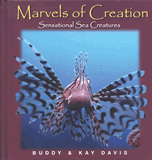
Movie Review: Dolphins and Whales: Tribes of the Ocean
Jean-Michel Cousteau’s Dolphins and Whales: Tribes of the Ocean is an amazing visual delight—with only a few scientific gaffes.
At a Glance
Quality: 8/10
Amazing visuals; narration is flawed; overly didactic
Science: 4/10
Hints of whale evolution; millions of years as fact; discussions of manatee “origins”
The power of an IMAX 3D theater is that the viewer feels completely immersed in the visual experience, as if you are right there with the imagery on the screen. This is certainly true of Jean-Michel Cousteau’s Dolphins and Whales: Tribes of the Ocean (released in 2008 and still playing around the world). Seeing whales and dolphins (cetaceans) on a six-story screen is about as close as most of us may ever get to many of these creatures.
For nearly an hour, you’ll be mesmerized by the beauty of the humpback whale’s song, thrilled by dolphin games (and their intelligence), and amazed by these wonderful mammals of the deep. In all, you’ll meet 11 whales and dolphins (and one manatee) from the Kingdom of Tonga to Canada’s Hudson Bay.
Creation
For the most part, the movie eschews discussions of evolution (see below for exceptions) and focuses more on how these animals live, eat, breed, and explore in the present, which is an example of clear observational science. The camera is always underwater and does a great job presenting life from the animals’ perspective. For example, the camera angle is a bit disorienting at first, but once you know that this movie is strictly about life below the waves, the direction of the camera becomes less bothersome.
The most gratifying part of the experience by far, however, is in seeing these animals so close. For most of the film, the camera seems as if it is nearly touching the cast of creatures, and Cousteau’s team does an excellent job capturing more than simply a medley of images. You don’t just see a humpback whale swimming by, you see (and hear) how these creatures live and interact with one another. You join in a game of “seaweed tag” with dolphins; you lounge around with a West Indian Manatee; and you hunt with an enormous finned whale that swallows a school of fish in one giant gulp. Truly, these animals were designed to master their habitat.
One of the best parts of the movie, from a creationist perspective, is that it highlights the similarity between whales and dolphins. Creationists have long shown that the two groups (seen especially with toothed whales and dolphins) are a great example of a baramin (created kind). That is, God originally created “kinds” and not all the species we have today. After the Curse, those kinds have become specialized and lost some of information that they once had. However, some species of cetaceans can still interbreed to create hybrids—often called “wholphins.”1 In fact, if each species were not explicitly introduced as “whale” or “dolphin,” there could easily be some confusion, without an understanding of marine biology.
The film explains, quite thoroughly, how endangered many of these creatures are, and creationists should certainly take notice. After all, God gave humanity a mandate in Genesis 1:28–29 to take care of the plants and animals that He has created. Sea creatures fall under this mandate, and many species of cetaceans are in danger of becoming extinct. Seeing them close up is apparently intended to make the viewer more sympathetic to this loss.
Evolution
The film, however, is not without its flaws. The movie mentions in passing, as if there is no debate, that the cetaceans have been around for “millions of years,” though they offer no evidence for this. This is a shame, since the target audience for this movie is likely to be school-aged children, and the film encourages them to accept the millions-of-years mantra without considering the issue for themselves. Most of the science is excellent observational science, which makes the age claim stand out even more.
The screens that introduce each species show the skeletal structure of the animals, including the supposed vestigial hind limbs buried in the flesh. This in itself is a teachable moment for any Christian parent. Although the film makes no mention of them, these structures have often been used to support the evolution of whales and dolphins from land mammals. That is, they are seen as the leftovers of legs. Occasionally, some whales and dolphins are supposed to show “flashbacks” to their leggy ancestors through atavism.2 However, it is important to point out that these structures are not useless pseudo-legs, but often have function in reproduction. In addition, it is possible that cetaceans once had hind fins that were subsequently lost. Yet again, as in most cases of claimed evolution, this is a loss or suppression of existing genetic information and not the development of new. You will find that supposed whale evolution depends a great deal on interpretations (and artists’ reconstructions) of fossils with very little evidence other than the belief that they must have evolved from land mammals.
The most overt example (and unintentionally comical) reference to evolution occurs in the West Indian manatee segment. For the most part, this segment sticks with observational science; however, this is the only segment that delves into the supposed “origin” of these amazing creatures. The film claims that DNA evidence suggests that manatees are related to elephants. Rather than a reasonable interpretation that they share some common design due to a common Designer, an evolutionary link is assumed. Too bad that many of the children who see this movie will take this at face value without being exposed to alternatives.
Similarity in DNA can reveal nothing by itself, and “relationships” are derived from the starting assumption that evolution is true. In fact, if you dig deeper, you will find from evolutionists that “[u]nlike whales or dolphins (Cetacea), the earliest evolutionary history of sirenians [manatees] is poorly documented, and limited to a few fossils including skulls and skeletons of two genera composing the stem family of Prorastomidae (Prorastomus and Pezosiren).”3 In other words, very little evidence exists for manatee evolution and what exists is fragmentary at best. Manatees, it would seem, have always been manatees (in fact, one of the most major changes seems to be that they lost a molar, a loss that somehow made them less “primitive”). Once again, a dogmatic claim does not stand up under scrutiny.
Finally, I found it ironic that the film preached conservation of these species and, at the same time, claimed evolution is fact. If evolution is true, why should humans care about saving the cetaceans? That is, if the fit survive, then the destruction of whales and dolphins should either prompt them to “evolve” so as to survive or to simply die off as just another animal that was not fit enough. Darwinism undermines the very premise for conservation. According to the belief system, animals have evolved for millions of years because of environmental pressure and predation. Shouldn’t those same animals continue to do so today? If one is truly an evolutionist, then he or she should expect cetaceans to adapt (as they supposedly did by returning to the sea) or die so other more fit creatures can take their place.
Other Negatives
The manatee section mentioned above has two other caveats. First, the movie is touted as concerning dolphins and whales, and the manatee, while interesting, seems an odd addition. Second, the segment also features bodily functions that some parents might not approve of (a scene which comes across as unnecessary and childish in contrast to the rest of the film). The English and narration is also occasionally sloppy and distracting.
One of the biggest issues I had with the film is the attitude toward conservation. Granted, Christians should take God’s mandate to care for the earth seriously. This is a cursed earth, to be sure, but we have a responsibility to use our resources wisely. Whales and Dolphins, however, spends nearly as much time shaming the viewer as it does discussing the animals. Climate change, hunting, and apathy are all mentioned as sources of destruction (and so they may very well be), but Daryl Hannah’s narration comes across as overly didactic.
Recommendation
Aside from one reference to millions of years and a smattering of evolution, the film has some amazing visuals that are worth the price of admission. Most of us will likely never get this close to whales and dolphins in their natural habitat. If you would like to take your children, be sure to discuss the claims concerning the manatees and millions of years before or after they see it. It’s a great way to show how presuppositions impact research and how claims of ancestry and homology are often just-so stories.
To find out more: http://www.dolphinsandwhales3d.com/
Footnotes
- Stephen Adams, Dolphin and Whale Mate to Create a ‘Wolphin,’ Telegraph.
- Ken Ham and David Menton, Dolphin Found with “Remains of Legs.”
- Julien Benoit et al., "Cranial Remain from Tunisia Provides New Clues for the Origin and Evolution of Sirenia (mammalia Afrotheria) in Africa." PLOS One (2013), https://journals.plos.org/plosone/article?id=10.1371/journal.pone.0054307. Editor’s note: This article has been updated to include a more recent study published in 2013.
Recommended Resources

Answers in Genesis is an apologetics ministry, dedicated to helping Christians defend their faith and proclaim the good news of Jesus Christ.
- Customer Service 800.778.3390
- Available Monday–Friday | 9 AM–5 PM ET
- © 2025 Answers in Genesis




